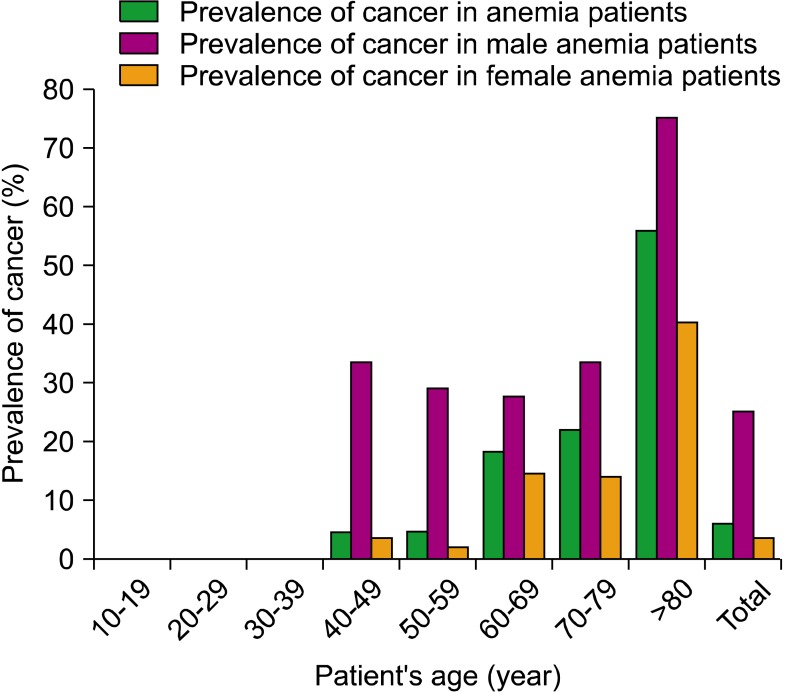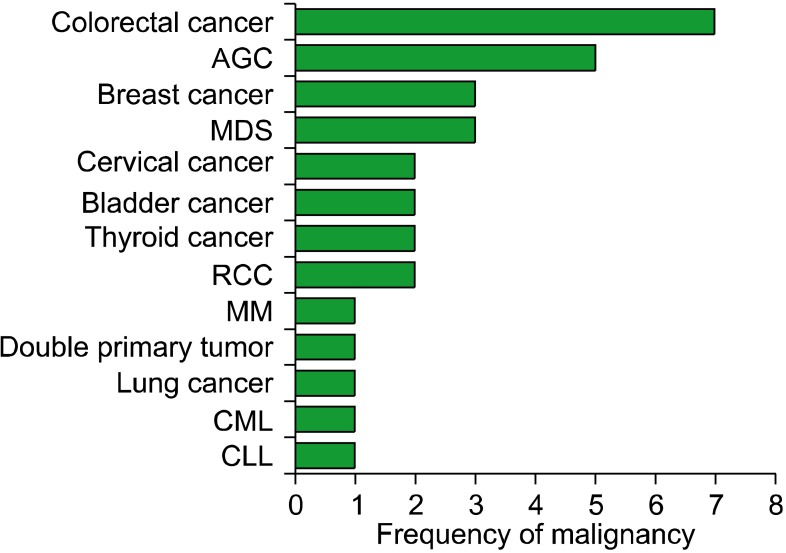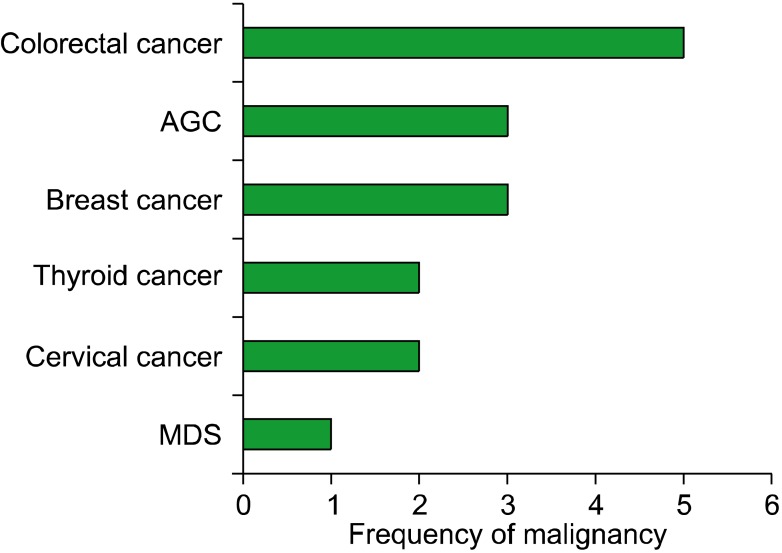Blood Res.
2013 Mar;48(1):46-50. 10.5045/br.2013.48.1.46.
The prevalence and clinical characteristics of cancer among anemia patients treated at an outpatient clinic
- Affiliations
-
- 1Department of Internal Medicine, Bucheon St. Mary's Hospital, The Catholic University of Korea, Bucheon, Korea. khrhee@gmail.com
- KMID: 2270726
- DOI: http://doi.org/10.5045/br.2013.48.1.46
Abstract
- BACKGROUND
Anemia is the most common hematologic condition encountered in outpatient clinics. It is often overlooked because it is common among patients; however, anemia is one of the leading indicators of cancer. This study examined the prevalence and characteristics of cancer among anemia patients who visited an outpatient clinic.
METHODS
The data were collected by reviewing the records of an outpatient clinic from January 2007 to December 2011.
RESULTS
In total, 502 patients (52 males, 450 females) were diagnosed with anemia. Cancer prevalence among anemia patients was 5.57% (25.0%, men; 3.3%, women); further, the most frequently diagnosed cancer was colorectal cancer (22.5%), followed by advanced gastric cancer (16.1%), breast cancer (9.6%), myelodysplastic syndrome (9.6%), cervical cancer (6.4%), renal-cell carcinoma (6.4%), and thyroid cancer (6.4%). The prevalence of cancer was 4.1% in those aged 40-49 years, 4.2% in the subjects in their fifties, 8.0% in those in their sixties, 21.6% in those in their seventies, and 55.6% in those aged over 80 years. The cancer prevalence among iron deficiency anemia (IDA) patients was 6.18% (28.8%, men; 3.5%, women). The cancer prevalence in postmenopausal and premenopausal female IDA patients was 16.0% and 1.6%, respectively.
CONCLUSION
Among anemia patients, male patients aged over 40 years and female patients aged over 60 years, along with postmenopausal female patients, were more likely to be diagnosed with cancer. Consequently, male IDA patients, and female patients aged over 60 years must be carefully evaluated for the possibility of malignancy.
Keyword
MeSH Terms
Figure
Cited by 1 articles
-
Comprehensive Analysis of Iron Deficiency Anemia and Its Related Disorders in Premenopausal Women Based on a Propensity Score Matching Case Control Study Using National Health Insurance Service Database in Korea
Hyun Jung Lee, Haeyong Pak, Jae Joon Han, Myung Hee Chang
J Korean Med Sci. 2023;38(37):e299. doi: 10.3346/jkms.2023.38.e299.
Reference
-
1. de Benoist B, McLean E, Egli I, Cogswell M, editors. Worldwide prevalence of anaemia 1993-2005. WHO global database on anaemia. 2008. Geneva, Switzerland: WHO Press;p. 1–40.2. Balducci L, Ershler WB. Cancer and ageing: a nexus at several levels. Nat Rev Cancer. 2005; 5:655–662. PMID: 16056261.
Article3. Culleton BF, Manns BJ, Zhang J, Tonelli M, Klarenbach S, Hemmelgarn BR. Impact of anemia on hospitalization and mortality in older adults. Blood. 2006; 107:3841–3846. PMID: 16403909.
Article4. Penninx BW, Cohen HJ, Woodman RC. Anemia and cancer in older persons. J Support Oncol. 2007; 5:107–113. PMID: 17410807.5. Atti AR, Palmer K, Volpato S, Zuliani G, Winblad B, Fratiglioni L. Anaemia increases the risk of dementia in cognitively intact elderly. Neurobiol Aging. 2006; 27:278–284. PMID: 15893409.
Article6. Penninx BW, Pluijm SM, Lips P, et al. Late-life anemia is associated with increased risk of recurrent falls. J Am Geriatr Soc. 2005; 53:2106–2111. PMID: 16398894.
Article7. Go AS, Yang J, Ackerson LM, et al. Hemoglobin level, chronic kidney disease, and the risks of death and hospitalization in adults with chronic heart failure: the Anemia in Chronic Heart Failure: Outcomes and Resource Utilization (ANCHOR) Study. Circulation. 2006; 113:2713–2723. PMID: 16754803.8. Wu WC, Rathore SS, Wang Y, Radford MJ, Krumholz HM. Blood transfusion in elderly patients with acute myocardial infarction. N Engl J Med. 2001; 345:1230–1236. PMID: 11680442.
Article9. Benson K, Balducci L, Aapro M. Balducci L, Ershler WB, Bennett JM, editors. Anemia and cancer. Anemia in the elderly. 2007. New York, NY: Springer;p. 99–113.
Article10. Ministry of Health and Welfare. The Korea central cancer registry. Annual report of cancer statistics in Korea in 2008. 2010. Seoul, Korea: Ministry of Health and Welfare.11. Chaves PH, Ashar B, Guralnik JM, Fried LP. Looking at the relationship between hemoglobin concentration and prevalent mobility difficulty in older women. Should the criteria currently used to define anemia in older people be reevaluated? J Am Geriatr Soc. 2002; 50:1257–1264. PMID: 12133021.
Article12. Penninx BW, Pahor M, Cesari M, et al. Anemia is associated with disability and decreased physical performance and muscle strength in the elderly. J Am Geriatr Soc. 2004; 52:719–724. PMID: 15086651.
Article13. DeMaeyer E, Adiels-Tegman M. The prevalence of anaemia in the world. World Health Stat Q. 1985; 38:302–316. PMID: 3878044.14. Goldman L, Schafer A, editors. Goldman's cecil medicine. 2011. 24th ed. Philadelphia, PA: Elsevier Saunders;p. 1031–1039.15. Kim SK, Kang HS, Kim CS, Kim YT. The prevalence of anemia and iron depletion in the population aged 10 years or older. Korean J Hematol. 2011; 46:196–199. PMID: 22065976.
Article16. Schwartz RN. Anemia in patients with cancer: incidence, causes, impact, management, and use of treatment guidelines and protocols. Am J Health Syst Pharm. 2007; 64(3 Suppl 2):S5–S13. PMID: 17244886.
Article17. Grotto HZ. Anaemia of cancer: an overview of mechanisms involved in its pathogenesis. Med Oncol. 2008; 25:12–21. PMID: 18188710.
Article18. Knight K, Wade S, Balducci L. Prevalence and outcomes of anemia in cancer: a systematic review of the literature. Am J Med. 2004; 116(Suppl 7A):11S–26S. PMID: 15050883.
Article19. Groopman JE, Itri LM. Chemotherapy-induced anemia in adults: incidence and treatment. J Natl Cancer Inst. 1999; 91:1616–1634. PMID: 10511589.
Article20. Miller CB, Jones RJ, Piantadosi S, Abeloff MD, Spivak JL. Decreased erythropoietin response in patients with the anemia of cancer. N Engl J Med. 1990; 322:1689–1692. PMID: 2342534.
Article
- Full Text Links
- Actions
-
Cited
- CITED
-
- Close
- Share
- Similar articles
-
- A study of screening for anemia in 9 month old infants in well baby clinic
- Pharmacotherapy in Childhood Anemia
- Prevalence of and Factors Associated with Malignancy in Males with Iron-Deficiency Anemia
- Impact of Life Style Characteristics on Prevalence Risk of Metabolic Syndrome
- Analysis of Prevalence of Anemia according to Severity of Atopic Dermatitis




